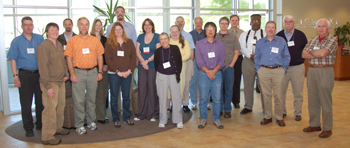Investing in the Future of Science
From its beginnings in 1886, Sigma Xi has sought to foster and encourage  research among investigators from all scientific disciplines. The Grants in Aid of Research program has been a tangible expression of this purpose for several generations of scientists and engineers. Since 1922, the program has invested in the future of science by awarding grants to more than 30,000 researchers, grants that in many cases have helped launch careers.
research among investigators from all scientific disciplines. The Grants in Aid of Research program has been a tangible expression of this purpose for several generations of scientists and engineers. Since 1922, the program has invested in the future of science by awarding grants to more than 30,000 researchers, grants that in many cases have helped launch careers.
Funded largely by the Society and administered by its members, the Sigma Xi Grants in Aid of Research program is unique among small-grant funding agencies in that it provides grants in all areas of science to encourage and facilitate research among young investigators. Grant proposals are judged solely on the basis of their scientific merit. Sigma Xi grants have funded research on everything from the Shoemaker-Levy Comet to the role of Taxol® in breast cancer therapy to behavioral and ecological studies on endangered species.
Photo: Elsa Youngsteadt, a GIAR recipient, working with ants in Peru.
A Distinguished History of Support
Although Sigma Xi began making research grants as early as 1922, the name "Grants in Aid" first appeared in 1932 when the Sigma Xi Quarterly reported that seven grants were to be awarded the following year under this title for a total of $1,900. This was an extraordinary amount when one considers that it was allocated during the depths of the Great Depression.
Today, Sigma Xi grant awards range from under $100 to $1000, with some special funds permitting larger grants. Overall, grants for the past year averaged about $650. The program has in recent years received an average of about 2,000 applications annually.
Grants in Aid of Research are open to undergraduate and graduate students. Requests from all disciplines of science are eligible for consideration. While most applicants are from the United States and Canada, awards have been made to students in many other countries, including Argentina, Australia, Brazil, Costa Rica, Estonia, Great Britain, Israel, Italy, Korea, Mexico, the Netherlands, Nigeria, Romania, Russia, Trinidad and Tobago, Turkey, and Zambia. Recipients do not have to be members of Sigma Xi; however, formal enrollment in a degree program is required.
A Helping Hand on the Road to Discovery
 In 1952, at the age of 23, graduate students Thomas Eisner and Edward O. Wilson received a Sigma Xi Grant in Aid of Research to take an entomological field trip across the United States. Both scientists would later become recipients of Sigma Xi's highest honor, the William Procter Prize for Scientific Achievement.
In 1952, at the age of 23, graduate students Thomas Eisner and Edward O. Wilson received a Sigma Xi Grant in Aid of Research to take an entomological field trip across the United States. Both scientists would later become recipients of Sigma Xi's highest honor, the William Procter Prize for Scientific Achievement.
"We got our grant — $200, as I remember it — and off we went," recalled Eisner, a winner of the National Medal of Science, who is Jacob Gould Schurman Professor of Chemical Ecology at Cornell University and director of the Cornell Institute for Research in Chemical Ecology. "Twelve thousand miles, more than 20 states, over a period of more than two months — in a 1942 Chevy with 160,000 miles on it. By the time we returned, our hood had torn loose in a storm, and one window had been broken away by a bear in Yellowstone. But what a trip — I don't think I ever learned so much in such a short time in my whole life! And it was really that grant-in-aid that allowed us to do it. I remain to this day eternally grateful."
Wilson, who is Pellegrino University Professor Emeritus at Harvard  University, has won two Pulitzer Prizes for his books On Human Natureand (with co-author Bert Holldobler) The Ants. In a preface to his Procter Prize Address, he fondly remembered that summer on the road to discovery. "We slept on the ground on inflatable rubber mattresses and cooked over an open fire. We lived on items like condensed milk, at 12 cents a can, and beans at 11 cans for a dollar. Gasoline, as I remember, was about 15 cents a gallon. It was one of the formative experiences of our lives, setting not just our doctoral thesis research, but the course of our entire lives. So I thank you for that, Sigma Xi, and thank you for the Procter Prize as well."
University, has won two Pulitzer Prizes for his books On Human Natureand (with co-author Bert Holldobler) The Ants. In a preface to his Procter Prize Address, he fondly remembered that summer on the road to discovery. "We slept on the ground on inflatable rubber mattresses and cooked over an open fire. We lived on items like condensed milk, at 12 cents a can, and beans at 11 cans for a dollar. Gasoline, as I remember, was about 15 cents a gallon. It was one of the formative experiences of our lives, setting not just our doctoral thesis research, but the course of our entire lives. So I thank you for that, Sigma Xi, and thank you for the Procter Prize as well."
Photo of Thomas Eisner courtesy of Cornell University Photography.
Volunteer Committee Reviews Applications
 The grant review committee has grown from three in 1932 to the present 25 committee and guest readers. Reviewers are Sigma Xi members from a variety of disciplines, who volunteer their time and expertise two times a year to review grant applications. It's a time-consuming process. Over the course of two, members read applications that pertain to their own research areas and expertise.
The grant review committee has grown from three in 1932 to the present 25 committee and guest readers. Reviewers are Sigma Xi members from a variety of disciplines, who volunteer their time and expertise two times a year to review grant applications. It's a time-consuming process. Over the course of two, members read applications that pertain to their own research areas and expertise.
Each application receives a reading by two committee members. Additional readers are asked to review a proposal if agreement is not reached on whether to fund it. The committee members do not review applications from their own institutions.
"Sigma Xi's Grants in Aid of Research Committee is undoubtedly the hardest working of any of the dozens of volunteer professional committees with which I have worked," said committee chair Raymond E. Fornes of North Carolina State University.
Providing the 'Seed Money' for Research
The size of Sigma Xi Grants in Aid of Research sometimes belies their  importance to young researchers. Often, they provide the "seed money" that enables promising researchers to gather the initial data they need to launch their careers and position themselves to compete for larger grants. As an independent endorsement of research potential, Grants in Aid of Research also have a value that goes beyond financial considerations. Sigma Xi is known as the honor society for scientists and engineers, and receiving a Sigma Xi grant has been an early milestone in many distinguished research careers.
importance to young researchers. Often, they provide the "seed money" that enables promising researchers to gather the initial data they need to launch their careers and position themselves to compete for larger grants. As an independent endorsement of research potential, Grants in Aid of Research also have a value that goes beyond financial considerations. Sigma Xi is known as the honor society for scientists and engineers, and receiving a Sigma Xi grant has been an early milestone in many distinguished research careers.
As an indication of how firmly established a tradition the program has become, the late Robert Marshak, who served as president of the American Physical Society and a Sigma Xi lecturer on particle physics, once noted that not only did he receive a Sigma Xi grant in 1940, but his son received one years later while a graduate student in geology.
Photo: Michael C. Scholl, GIAR recipient, identifying great white sharks in the waters off South Africa.
Grants Represent a Valuable Endorsement
Mary Ellen Smajo spoke for many recipients when she described what a Sigma Xi Grant in Aid of Research meant to her. Smajo received her grant while a doctoral candidate at Rush-Presbyterian — St. Luke's Medical Center in Chicago. Her project involved three-dimensional mapping of radiation doses using magnetic resonance imaging.
"My research topic was new to our department, and I started with nothing," she said. "While $300 may not sound like a lot of money, it was enough to enable me to show the feasibility of my proposed dissertation work. More importantly, this award provided the assurance that scientists outside our department judged my work to be of value and worthy of funding. These factors proved to be instrumental in the awarding of a second larger grant from our institution."
During Sigma Xi's Centennial observance in 1986, Cornell University President Frank H.T. Rhodes summed up the significance of the Grants in Aid program:
"Though the financial support that it provides is always welcome, it also provides something no less vital in the encouragement, professional support and independent judgment that are needed to confirm the worth of particular research endeavors and to provide the recipient with a sense of confidence and commitment needed for a lifetime of productive scientific inquiry."
How the Program is Funded
The funds for the Grants in Aid of Research program originally came from individual members and grew to include donations from Sigma Xi chapters. This funding continues today. Major early landmarks in fundraising for the program include the Semi-Centennial Fund, established in 1936 to encourage research, and the Harlow Shapley Fund, created in 1968 to honor Shapley's long-time service as chairman of the Committee on Grants in Aid of Research.
In 1977, the Society's membership voted to provide the program with $1 from each member's annual dues (exempting emeritus, life and student members) and an additional dollar in 1981. In 2005, delegates at the Society's Annual Meeting voted to increase this contribution to $4. Today the Board of Directors sets aside an appropriate sum in addition to annual contributions from Sigma Xi members, to which the income from the endowed fund is added.
Partners
Since 1984, the National Academy of Sciences has contracted with the Society to distribute the Academy’s funds designated for research. Funds from the National Academy of Sciences allow for grants of up to $5,000 for astronomy research and $2,500 for vision related research. Academy funds designated for research include:
- Alexander Bache Fund - physical and natural sciences
- Edmond and Marianne Blaauw Fund - vision research
- Wolcott Gibbs Fund - chemistry
- Benjamin Apthrop Gould Fund - astronomy
- Joseph Henry Fund - natural sciences
- O. C. Marsh Fund - natural sciences
- George P. Merrill Award - research in meteors, meteorites and space
Generous Support Over the Years
Many past recipients of Grants in Aid of Research, as well as Sigma Xi members, have contributed generously over the years to the program, ensuring that future generations of scientists and engineers will get a helping hand as they launch their research careers. That help has never been needed more than it is today, given the intense competition for other forms of grant funding, in which the beginning researcher is often at a disadvantage.
Members are given the option to contribute to the Grants in Aid of Research program when they pay their annual Sigma Xi dues. Canadian members can contribute to a special Grants in Aid of Research fund for Canadian researchers.
Throughout the year, contributions (which are generally tax-deductible in the United States and Canada) can be made to the program's general endowment fund by making a check payable to Sigma Xi, designated for Grants in Aid of Research, and mailing it to:
Office of Development
Sigma Xi, The Scientific Research Society
P.O. Box 13975
Research Triangle Park, NC 27709
Within the Grants in Aid of Research endowment, there are a number of named funds designated in support of general research or specific fields of investigation. Any individual or organization may establish a named fund by agreeing to contribute $25,000 to the endowment within a three-year period. The donor may designate the field of research that the fund will support. For more information on establishing a named fund, contact Sigma Xi's Office of Development at the above address or call 800-243-6534 or 919-549-4691.
Visit the GIAR Centennial Campaign page for more information on how you can support the Grants in Aid of Research program.